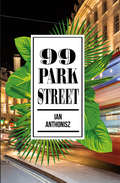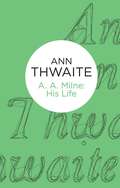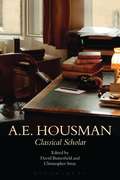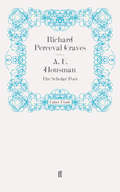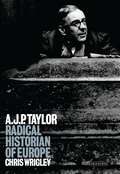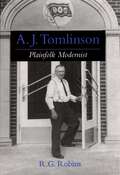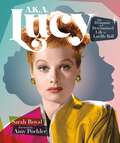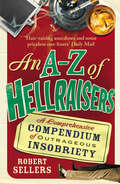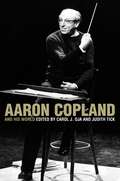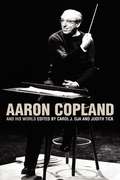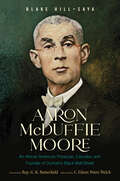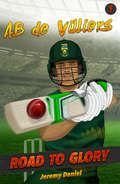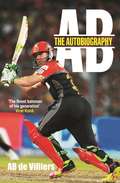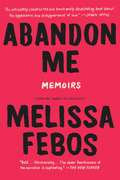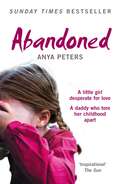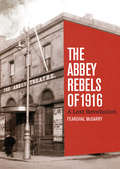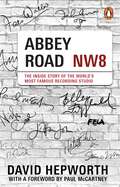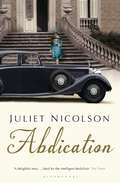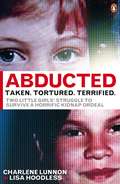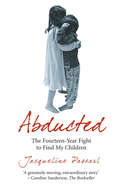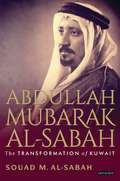- Table View
- List View
99 Park Street
by Ian AnthoniszWhen Ian Anthonisz first arrived in Britain as a young Ceylonese man, he knew he had the world at his feet. Despite his humble beginnings and growing up in a family of modest means in Ceylon - the country we know today as Sri Lanka - and the unique challenges of being a first generation immigrant, Ian Anthonisz has achieved the gold plated Western dream of success through a combination of tenacity and self-belief. Not to mention a very British sense of humour! This is the story of an immigrant boy’s journey to the top, written with honesty and humility, a message of hope and perseverance against the odds.
a: A Novel
by Andy WarholPart novel, part Pop artwork, Andy Warhol's a is an electrifying slice of life at his Factory studio'A work of genius' NewsweekIn the early 1960s, Andy Warhol set out to turn the novel into pop art. a, the first book he wrote, is the result. Transcribed from audiotapes recorded in and around his legendary art studio, it begins with the actor Ondine popping pills, then follows a cast of thinly-disguised superstars, musicians and prima donnas as they run riot through Manhattan. A knowing response to James Joyce's Ulysses, using the freewheeling, spontaneous techniques as Warhol's visual art, this filthy, funny book is a uniquely creative insight into Factory life.'Hellish hymns from Amphetamine Heaven, the vox populi of the Velvet Underground ... These people are witty and they are grand, they do terrible things and make awful remarks' New York Review of Books
A. A. Milne: His Life
by Ann ThwaiteA.A. Milne is one of the most successful English writers ever. His heart-warming creations—Winnie-the-Pooh, Christopher Robin, Eeyore, Tigger and Piglet—have become some of the best-loved children’s characters of all time, and readers the world over are familiar with the stories from the Hundred Acre Wood. Yet the man himself has remained an enigma. Although in many ways his behaviour was that of a typical golf-playing, pipe-smoking Englishman, Milne refused to be typecast, and his publishers despaired when he turned from writing popular columns for Punch to writing detective stories. They complained again when the detective writer presented them with a set of children’s verse, but when When We Were Very Young became one of the best-selling books of all time, Milne’s credibility as one of the world’s favorite authors was sealed. In this biography of Milne, Ann Thwaite reveals the man himself, in all his complexity. As W. A. Darlington put it in 1921, commenting on Milne’s highly popular plays, ‘Mr Milne is obviously at heart (like all humorists) a serious person, with things to say.’ He had strong political feelings, and was a pacifist even before his experiences on the Somme in 1916. There was always something darker and more tangled under ‘the bright glitter of surfaces’. At his father’s school, Milne was taught by the young H. G. Wells, who remained a lifelong friend; later, J. M. Barrie called him ‘my Mr Milne’ and was ‘uncommon proud of him’; later still, P. G. Wodehouse became one of his greatest admirers, and a friend – but was then deeply hurt by Milne’s strong reaction to the notorious wartime broadcasts. Milne’s personal relationships, including those with his wife and son, were not always easy. In A. A. Milne: His Life, Ann Thwaite has produced a vivid, sympathetic and entertaining portrait of both the man and his work, set in the context of his time, which stands as the definitive life of a writer whose work has earned some loathing (for its supposed ‘whimsy’) but much more devotion among readers of all ages, not only in English-speaking countries but all over the world.
A. E. Housman: A Single Life
by Martin BlocksidgeA.E. Housman's poetry (especially A Shropshire Lad) remains well-known, widely read and often quoted. However, Housman did not view himself as a professional poet, always making quite clear that his 'proper job' was as a Professor of Latin. Housman's fame as a poet has often obscured the fact that he was the leading British classical scholar of his generation, and a Cambridge Professor. It has also sometimes been suggested that Housman's two areas of activity are the sign of a flawed or 'divided' personality. A.E. Housman: A Single Life argues that there is no fundamental tension between Housman the poet and Housman the scholar, and his career is presented very much as that of a working academic who also wrote poetry. The book gives a full account of what Housman described as 'the great and real troubles of my early manhood', and in particular his unrequited and life-long love for his undergraduate friend Moses Jackson. It resists the temptation to classify Housman too exclusively as a melancholic, and is sceptical about Housman's reputed rudeness and misanthropy, pointing out that, though Housman was famously aloof in manner, he was notably loyal and generous, courteous in his daily dealings and generally liked by those who knew him. He also possessed a highly developed sense of the absurd and a ready and often disconcerting wit, features which characterised not only his letters and miscellaneous writings, but also, famously, much of his scholarly work.
A. E. Housman: A Single Life
by Martin BlocksidgeA.E. Housman's poetry (especially A Shropshire Lad) remains well-known, widely read and often quoted. However, Housman did not view himself as a professional poet, always making quite clear that his 'proper job' was as a Professor of Latin. Housman's fame as a poet has often obscured the fact that he was the leading British classical scholar of his generation, and a Cambridge Professor. It has also sometimes been suggested that Housman's two areas of activity are the sign of a flawed or 'divided' personality. A.E. Housman: A Single Life argues that there is no fundamental tension between Housman the poet and Housman the scholar, and his career is presented very much as that of a working academic who also wrote poetry. The book gives a full account of what Housman described as 'the great and real troubles of my early manhood', and in particular his unrequited and life-long love for his undergraduate friend Moses Jackson. It resists the temptation to classify Housman too exclusively as a melancholic, and is sceptical about Housman's reputed rudeness and misanthropy, pointing out that, though Housman was famously aloof in manner, he was notably loyal and generous, courteous in his daily dealings and generally liked by those who knew him. He also possessed a highly developed sense of the absurd and a ready and often disconcerting wit, features which characterised not only his letters and miscellaneous writings, but also, famously, much of his scholarly work.
A.E. Housman: Classical Scholar
by David Butterfield Christopher StrayA.E. Housman (1859-1936) was a man of many apparent contradictions, most of which remain unresolved 150 years after his birth. At once a deeply emotive lyric poet and a precise and dedicated classical scholar, he achieved fame in both of these diverse disciplines. Although his poetic legacy has received much scholarly analysis, and yet more attention has been devoted to reconstructing his private life, no previous work has focused on Housman the classical scholar; yet it is upon scholarship that Housman most wished to leave his mark. This timely collection of papers by leading scholars reassesses the breadth and significance of Housman's contribution to classical scholarship in both his published and unpublished writings, and discusses how his mantle has been passed on to later generations of classicists.
A.E. Housman: Classical Scholar
by David Butterfield Christopher StrayA.E. Housman (1859-1936) was a man of many apparent contradictions, most of which remain unresolved 150 years after his birth. At once a deeply emotive lyric poet and a precise and dedicated classical scholar, he achieved fame in both of these diverse disciplines. Although his poetic legacy has received much scholarly analysis, and yet more attention has been devoted to reconstructing his private life, no previous work has focused on Housman the classical scholar; yet it is upon scholarship that Housman most wished to leave his mark. This timely collection of papers by leading scholars reassesses the breadth and significance of Housman's contribution to classical scholarship in both his published and unpublished writings, and discusses how his mantle has been passed on to later generations of classicists.
A. E. Housman: The Scholar-Poet
by Richard Perceval GravesA. E. Housman, romantic poet and classical scholar, is best-known as the author of A Shropshire Lad and the meticulous editor of Manilius, the Latin poet of astronomy.In this first full biography, Richard Perceval Graves convincingly reconciles the two apparently conflicting sides of Housman's personality, and reassesses the reputation of a man who was something of a mystery even to his closest friends.'This is bound to become the standard life.' John Carey, Sunday Times'Dispassionate and well-researched.' Philip Larkin, Guardian
A.J.P.Taylor: Radical Historian of Europe
by C.J. WrigleyA.J.P. Taylor - a gentleman scholar in the old style; a non-conforming radical from the north of England; an academic steeped in Oxford traditions; a late 20th-century British media personality; one of the most outstanding historians of his age. C.J.Wrigley's biography brings out fascinating, hitherto unrevealed details of this extraordinary man's life. It gives a vivid picture of his pampered childhood, his rivalry with Hugh Trevor-Roper, his complex relationships with women, and his time as a teacher, broadcaster, historian and incorrigible bête noir to many another scholar. Taking into account Taylor's own conviction about history's place at the heart of national consciousness, this full and enthralling portrait of a highly complicated figure assesses his achievements as both man and historian.
A. J. Tomlinson: Plainfolk Modernist (Religion in America)
by R. G. RobinsA.J. Tomlinson (1865-1943) ranks among the leading figures of the early Pentecostal movement, and like so many of his cohorts, he was as complex as he was colorful. Arriving in Appalachia as a home missionary determined to uplift and evangelize poor mountain whites, he stayed to become the co-founder and chief architect of the Church of God (Cleveland, TN) and the Church of God of Prophecy, which together with their minor offspring now constitute the third-largest denominational family within American Pentecostalism. R.G. Robins's biography recreates the world in which Tomlinson operated, and through his story offers a new understanding of the origins of the Pentecostal movement. Scholars have tended to view Pentecostalism as merely one among many anti-modernist movements of the early twentieth century. Robins argues that this is a misreading of the movement's origins-the result of projecting the modernist/fundamentalist controversy of the 1920s back onto the earlier religious landscape. Seeking to return the story of Pentecostalism to its proper historical context, Robins suggests that Pentecostalism should rightly be seen as an outgrowth of the radical holiness movement of the late nineteenth century. He argues that, far from being anti-modern, Pentecostals tended to embrace modernity. Pentecostal modernism, however, was a working class or "plainfolk" phenomenon, and it is the plainfolk character of the movement that has led so many scholars to mislabel it as anti-modern or fundamentalist. Through the compelling narrative of Tomlinson's life story, Robins sheds new light on late-nineteenth and early-twentieth century American religion, and provides a more refined lens through which to view the religious dynamics of our own day. v
A.K.A. Lucy: The Dynamic and Determined Life of Lucille Ball
by Sarah RoyalThis stunning package offers a rich, intimate, and highly entertaining look at the remarkable life and work of the television pioneer, the First Lady of Comedy, the legend, Lucille Ball—AKA Lucy. Full of fresh perspective, gorgeously designed, and richly informative, this is a book on Lucille Ball like none other. With profiles spotlighting the many different facets of the woman, AKA Lucy details how Ball changed the face of comedy and the entertainment industry. It sheds new light on the star's history, from her childhood through hard-scrabble days trying to make it in show business, falling head over heels in love and embarking on one of the great romances of the twentieth century, to becoming the biggest star in the world, a pioneer in television, and an icon for the ages. Filled with photos and highlighted by bright illustration and design, this is a volume almost as vivid and entertaining as the woman herself.AKA Lucy is officially authorized by the estate of Lucille Ball and Desi Arnaz.
An A-Z of Hellraisers: A Comprehensive Compendium of Outrageous Insobriety
by Robert SellersAn A-Z of Hellraisers is the last word on inebriated misbehaviour, and the miscreant mob in this whopper of a book constitute the most amazing grouping to see print: from Alexander the Great, whose drunken revelries once ended with the destruction of an entire city; to W. C. Fields, who passed critical judgement on a brass band by urinating over them from a hotel balcony; Dylan Thomas, who drove a sports car onto Charlie Chaplin's private tennis court; to Led Zeppelin drummer John Bonham, suffocating on his own vomit after consuming forty measures of vodka - what a night out that was!This hilarious volume makes for an ideal bedside companion or pub reading fodder, as it scrutinises and salutes these glorious individuals, from Winston Churchill to Keith Moon, George Best to Ernest Hemingway, Wild Bill Hickok to Sam Peckinpah, Ozzy Osbourne to Errol Flynn. Just thank God we didn't have to live next door to any of them.
Aaron Copland and His World (The Bard Music Festival)
by Judith Tick Carol J. OjaAaron Copland and His World reassesses the legacy of one of America's best-loved composers at a pivotal moment--as his life and work shift from the realm of personal memory to that of history. This collection of seventeen essays by distinguished scholars of American music explores the stages of cultural change on which Copland's long life (1900 to 1990) unfolded: from the modernist experiments of the 1920s, through the progressive populism of the Great Depression and the urgencies of World War II, to postwar political backlash and the rise of serialism in the 1950s and the cultural turbulence of the 1960s. Continually responding to an ever-changing political and cultural panorama, Copland kept a firm focus on both his private muse and the public he served. No self-absorbed recluse, he was very much a public figure who devoted his career to building support systems to help composers function productively in America. This book critiques Copland's work in these shifting contexts. The topics include Copland's role in shaping an American school of modern dance; his relationship with Leonard Bernstein; his homosexuality, especially as influenced by the writings of André Gide; and explorations of cultural nationalism. Copland's rich correspondence with the composer and critic Arthur Berger, who helped set the parameters of Copland's reception, is published here in its entirety, edited by Wayne Shirley. The contributors include Emily Abrams, Paul Anderson, Elliott Antokoletz, Leon Botstein, Martin Brody, Elizabeth Crist, Morris Dickstein, Lynn Garafola, Melissa de Graaf, Neil Lerner, Gail Levin, Beth Levy, Vivian Perlis, Howard Pollack, and Larry Starr.
Aaron Copland and His World (PDF)
by Carol J. Oja Judith TickAaron Copland and His World reassesses the legacy of one of America's best-loved composers at a pivotal moment--as his life and work shift from the realm of personal memory to that of history. This collection of seventeen essays by distinguished scholars of American music explores the stages of cultural change on which Copland's long life (1900 to 1990) unfolded: from the modernist experiments of the 1920s, through the progressive populism of the Great Depression and the urgencies of World War II, to postwar political backlash and the rise of serialism in the 1950s and the cultural turbulence of the 1960s. Continually responding to an ever-changing political and cultural panorama, Copland kept a firm focus on both his private muse and the public he served. No self-absorbed recluse, he was very much a public figure who devoted his career to building support systems to help composers function productively in America. This book critiques Copland's work in these shifting contexts. The topics include Copland's role in shaping an American school of modern dance; his relationship with Leonard Bernstein; his homosexuality, especially as influenced by the writings of André Gide; and explorations of cultural nationalism. Copland's rich correspondence with the composer and critic Arthur Berger, who helped set the parameters of Copland's reception, is published here in its entirety, edited by Wayne Shirley. The contributors include Emily Abrams, Paul Anderson, Elliott Antokoletz, Leon Botstein, Martin Brody, Elizabeth Crist, Morris Dickstein, Lynn Garafola, Melissa de Graaf, Neil Lerner, Gail Levin, Beth Levy, Vivian Perlis, Howard Pollack, and Larry Starr.
Aaron McDuffie Moore: An African American Physician, Educator, and Founder of Durham's Black Wall Street
by Blake Hill-SayaAaron McDuffie Moore (1863–1923) was born in rural Columbus County in eastern North Carolina at the close of the Civil War. Defying the odds stacked against an African American of this era, he pursued an education, alternating between work on the family farm and attending school. Moore originally dreamed of becoming an educator and attended notable teacher training schools in the state. But later, while at Shaw University, he followed another passion and entered Leonard Medical School. Dr. Moore graduated with honors in 1888 and became the first practicing African American physician in the city of Durham, North Carolina. He went on to establish the Durham Drug Company and the Durham Colored Library; spearhead and run Lincoln Hospital, the city's first secular, freestanding African American hospital; cofound North Carolina Mutual Life Insurance Company; help launch Rosenwald schools for African American children statewide; and foster the development of Durham's Hayti community. Dr. Moore was one-third of the mighty "Triumvirate" alongside John Merrick and C. C. Spaulding, credited with establishing Durham as the capital of the African American middle class in the late nineteenth and early twentieth centuries and founding Durham's famed Black Wall Street. His legacy can still be seen on the city streets and country backroads today, and an examination of his life provides key insights into the history of Durham, the state, and the nation during Reconstruction and the beginning of the Jim Crow Era.
AB de Villiers: Road to Glory (Road to Glory #0)
by Jeremy Daniel‘AB hopped over the boundary rope and onto the field, grinning at the sight and sound of a packed Wanderers Stadium. He swung his bat from side to side and listened to the crowd roaring his name.’So begins the wonderfully entertaining story of the rise to fame of one of South Africa’s favourite sporting stars. Written specifically for youngsters aged 10 –14, it takes the reader close to all the action, and the ups and downs.AB was already building a name as a great schoolboy tennis and rugby player, but when he decided to focus on cricket the word spread quickly about a talent that could not be contained. With two brothers a lot older than him, AB learned early how to play hard and never give up. In this inspiring story we watch as AB progresses through high school, then ’varsity, and learns how to play against the best. In his first Test series, AB struggles and wonders if he’s good enough to make it at this level. However, the outcome is an inspiration to sports fans and readers who love a good story.
AB de Villiers - The Autobiography
by A B Villiers'AB has become the most valuable cricketer on the planet' Adam GilchristAB de Villiers is one of the finest batsmen ever to play cricket, and yet his achievement extends beyond his outrageous armoury of drives, pulls, paddles, scoops and flicks.Whether he is delighting home crowds at the Wanderers or Newlands or setting new records in Bengaluru or Sydney, he plays the game in a whole-hearted manner that projects a positive image of his country around the world, and also makes millions of South Africans feel good about themselves.This is AB's story, in his own words. The story of the youngest of three talented, sports-mad brothers growing up in Warmbaths, of a boy who excelled at tennis, rugby and cricket, of a youngster who made his international debut at the age of twenty and was then selected in every single test played by South Africa for the next eleven seasons, of a batsman who has started to redefine the art, being ranked among the world's very best in test, ODI and T20.Through all the pyrotechnics and consistency, AB has remained a true sportsman - quick to deflect praise, swift to praise opponents, eager to work hard, to embrace the team's next challenge and to relish what he still regards as the huge privilege of representing his country. This is the story of a modern sporting phenomenon.
Abandon Me: Memoirs
by Melissa FebosNamed One of the Best Books of the year by:Esquire, Refinery29, LitHub, BookRiot, Medium, Electric Literature, The Brooklyn Rail, Vol. 1 Brooklyn, Largehearted Boy, The Coil and The Cut.Winner of the Lambda Literary Jeanne Cordova Prize for Lesbian/Queer NonfictionFinalist, Lambda Literary Award for Lesbian Memoir/BiographyFinalist, Publishing Triangle's Judy Grahn Award for Lesbian NonfictionAn Indie Next PickFor readers of Maggie Nelson and Leslie Jamison, a fierce and dazzling personal narrative that explores the many ways identity and art are shaped by love and loss.In her critically acclaimed memoir, Whip Smart, Melissa Febos laid bare the intimate world of the professional dominatrix, turning an honest examination of her life into a lyrical study of power, desire, and fulfillment. In her dazzling Abandon Me, Febos captures the intense bonds of love and the need for connection -- with family, lovers, and oneself. First, her birth father, who left her with only an inheritance of addiction and Native American blood, its meaning a mystery. As Febos tentatively reconnects, she sees how both these lineages manifest in her own life, marked by compulsion and an instinct for self-erasure. Meanwhile, she remains closely tied to the sea captain who raised her, his parenting ardent but intermittent as his work took him away for months at a time. Woven throughout is the hypnotic story of an all-consuming, long-distance love affair with a woman, marked equally by worship and withdrawal. In visceral, erotic prose, Febos captures their mutual abandonment to passion and obsession -- and the terror and exhilaration of losing herself in another. At once a fearlessly vulnerable memoir and an incisive investigation of art, love, and identity, Abandon Me draws on childhood stories, religion, psychology, mythology, popular culture, and the intimacies of one writer's life to reveal intellectual and emotional truths that feel startlingly universal.
Abandoned: The True Story Of A Little Girl Who Didn't Belong
by Anya PetersSeparated from her real mother at birth, Anya grew up in terror of her drunken bullying uncle. Beaten, humiliated and sexually abused by him from the age of six, she thought her life couldn't get worse. But one day it did.
The Abbey Rebels of 1916: A Lost Revolution
by Fearghal McGarryThe story of the 1916 Easter Rising and its aftermath from a new persepectiveThe Abbey Theatre played a leading role in the politicisation of the revolutionary generation that won Irish freedom, but comparatively little is known about the men and women who formed the lifeblood of the institution: those whose radical politics drove them to fight in the 1916 Rising.Drawing on a huge range of previously unpublished material, The Abbey Rebels of 1916 explores the experiences, hopes and dreams of these remarkable but largely forgotten individuals: Máire Nic Shiubhlaigh, the Abbey’s first leading lady; Peadar Kearney, author of the national anthem; feminist Helena Molony, the first female political prisoner of her generation; Seán Connolly, the first rebel to die in the Rising; carpenter Barney Murphy; usherette Ellen Bushell; and Hollywood star Arthur Shields.Invigorating and provocative, this is the story of how, in the years following the Easter Rising, the radical ideals that inspired their revolution were gradually supplanted by a conservative vision of the nation Ireland would become. Lavishly illustrated with 200 documents and images, it provides a fresh and compelling account of the Rising and its aftermath.
Abbey Road: The Inside Story of the World’s Most Famous Recording Studio (with a foreword by Paul McCartney)
by David HepworthWith a foreword by Paul McCartney'We wanted to live the mystique of this legendary studio' Kanye West 'There are certain things that are mythical. Abbey Road is mythical' Nile RodgersMany people will recognise the famous zebra crossing. Some visitors may have graffitied their name on its hallowed outer walls. Others might even have managed to penetrate the iron gates. But what draws in these thousands of fans here, year after year? What is it that really happens behind the doors of the most celebrated recording studio in the world?It may have begun life as an affluent suburban house, but it soon became a creative hub renowned around the world as a place where great music, ground-breaking sounds and unforgettable tunes were forged - nothing less than a witness to, and a key participant in, the history of popular music itself.What has been going on there for over ninety years has called for skills that are musical, creative, technical, mechanical, interpersonal, logistical, managerial, chemical and, romantics might be tempted add, close to magic.This is for the people who believe in the magic.
Abdication
by Juliet NicolsonEngland, 1936. After the recent death of George V, the nation has a new king, Edward VIII. But for all the confident pomp and ceremony of the accession, it is a turbulent time. Terrible poverty and unemployment affect many, but trouble few among the ruling elite; for others, Oswald Mosley's New Party, which offers a version of the fascism on the rise in Germany, seems to offer the vision of the future. Nineteen-year-old May Thomas has just disembarked at Liverpool Docks after making the long journey by steamer from Barbados to escape the constraints of her sugar-plantation childhood. Her first job as a secretary and chauffeuse to Sir Philip Blunt, Chief Whip in Baldwin's Conservative government, will open her eyes to the upper echelons of British society... The unlikely friendship she forms with Evangeline Nettlefold, American god-daughter of the Chief Whip's wife and an old school friend of Wallis Simpson, will see her through family upheavals including the shocking, sudden loss of her mother; but more significant for May, the Blunts' son Rupert has an Oxford University friend, Julian, a young man of conscience for whom, despite all barriers of class, she cannot help but fall. Secrets, hidden truths, undeclared loves, unspoken sympathies and covert complicities are everywhere - biggest and most dangerous of them all, the truth about the new King's relationship with a married woman, and the silent horror that few in Britain dare voice: the increasing inevitability of another world war...
Abducted
by Charlene Lunnon Lisa HoodlessIn 1999, at the tender age of ten, Charlene Lunnon and Lisa Hoodless were snatched as they walked to school. Over the next week, they were held captive, tortured, raped and almost killed. News of the girls' disappearance dominated the headlines, and the entire country held its breath, praying for their safe return as a massive police hunt failed to turn up any clues. But then a miracle happened. The girls were found alive, their abductor was arrested and the case was closed.But there was to be no such closure for Charlene and Lisa. Over the coming years, their friendship was strained to breaking point, as they struggled to reconcile themselves to their painful memories and to each other. Abducted is their astonishing first-hand, insider account of how it feels to be kidnapped, how they survived their horrific ordeal and how they have found the strength to move on and rebuild their lives.
Abducted: The Fourteen-Year Fight to Find My Children
by Jacqueline PascarlAt seventeen, Jacqueline Pascarl married a royal prince and embarked on what she believed would be a fairy-tale existence. But it soon became a nightmare. After years of abuse at the hands of her husband, Jacqueline escaped with her children, hoping to leave her past behind. But what followed would haunt her for the next fourteen years.In this heart-rending story, Jacqueline describes how her husband kidnapped their two young children and forced them to cut off all contact with her. She tells of the pain and helplessness she felt at their loss but also of how she channelled her grief, forging an existence as an aid worker and humanitarian ambassador, all the while desperately hoping to hear news of them.In 2006, she was reunited with her long-lost children, and in Abducted she reveals the dramatic events that led to their meeting. This is a candid, compelling account of living under the shadow of child abduction. It is an unforgettable ride through tragedy, loss and, finally, triumph.
Abdullah Mubarak Al-Sabah: The Transformation of Kuwait
by Souad M. Al-SabahSheikh Mubarak was the founder of the modern state of Kuwait. But the man who actually led Kuwait to modernity was his son Abdullah Mubarak Al-Sabah, one of the most significant figures of Kuwait from the 1940s to Kuwaiti independence in 1961. Largely responsible for the creation of the Kuwaiti defence forces, Abdullah Mubarak Al-Sabah made a point of prioritising what he saw to be Kuwait's national interests in the face of British, American and Iranian pressures during a crucial period of change. He developed carefully crafted, cautious relations with foreign oil companies and secured Kuwait's economic standing through his driven and single-minded policies.
